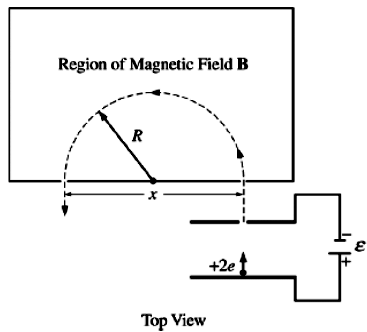
Your research director has assigned you to set up the laboratory’s mass spectrometer so that it will separate strontium ions having a net charge of +2e from a beam of mixed ions. The spectrometer above accelerates a beam of ions from rest through a potential difference ε , after which the beam enters a region containing a uniform magnetic field B of constant magnitude and perpendicular to the plane of the path of the ions. The ions leave the spectrometer at a distance x from the entrance point. You can manually change ε
Numerical values for this experiment:
Strontium atomic number: 38
Strontium ion mass: 1.45 x 10–25 kg
Magnitude of B field: 0.090 T
Desired exit distance x: 1.75 m
(a) In what direction must B point to produce the trajectory of the ions shown?
(b) The ions travel at constant speed around the semicircular path. Explain why the speed remains constant.
(c) Calculate the speed of the ions with charge +2e that exit at distance x.
(d) Calculate the accelerating voltage E needed for the ions with charge +2e to attain the speed you calculated in part (c).